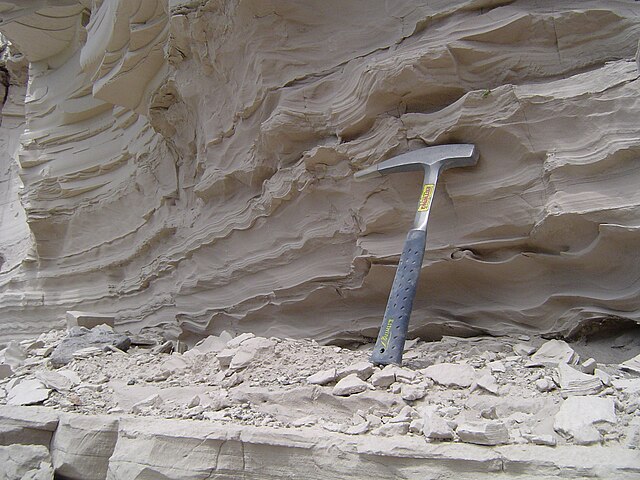Diagenesis is the process that describes physical and chemical changes in sediments first caused by water-rock interactions, microbial activity, and compaction after their deposition. Increased pressure and temperature only start to play a role as sediments become buried much deeper in the Earth's crust. In the early stages, the transformation of poorly consolidated sediments into sedimentary rock (lithification) is simply accompanied by a reduction in porosity and water expulsion, while their main mineralogical assemblages remain unaltered. As the rock is carried deeper by further deposition above, its organic content is progressively transformed into kerogens and bitumens.
A form of diagenesis is permineralization, in which buried organisms are replaced by minerals. These trilobites (Lloydolithus) were replaced by pyrite during a specific type of permineralization called pyritization.
Originally calcitic crinoid stem (in cross-section) diagenetically replaced by marcasite in a siderite concretion; Lower Carboniferous.
Sedimentary rocks are types of rock that are formed by the accumulation or deposition of mineral or organic particles at Earth's surface, followed by cementation. Sedimentation is the collective name for processes that cause these particles to settle in place. The particles that form a sedimentary rock are called sediment, and may be composed of geological detritus (minerals) or biological detritus. The geological detritus originated from weathering and erosion of existing rocks, or from the solidification of molten lava blobs erupted by volcanoes. The geological detritus is transported to the place of deposition by water, wind, ice or mass movement, which are called agents of denudation. Biological detritus was formed by bodies and parts of dead aquatic organisms, as well as their fecal mass, suspended in water and slowly piling up on the floor of water bodies. Sedimentation may also occur as dissolved minerals precipitate from water solution.

Middle Triassic marginal marine sequence of siltstones (reddish layers at the cliff base) and limestones (brown rocks above), Virgin Formation, southwestern Utah, U.S.
Uluru (Ayers Rock) is a large sandstone formation in Northern Territory, Australia.
Claystone deposited in Glacial Lake Missoula, Montana, United States. Note the very fine and flat bedding, common for deposits coming from lake beds further away from the source of sediment.
Sedimentary rock with sandstone in Malta






